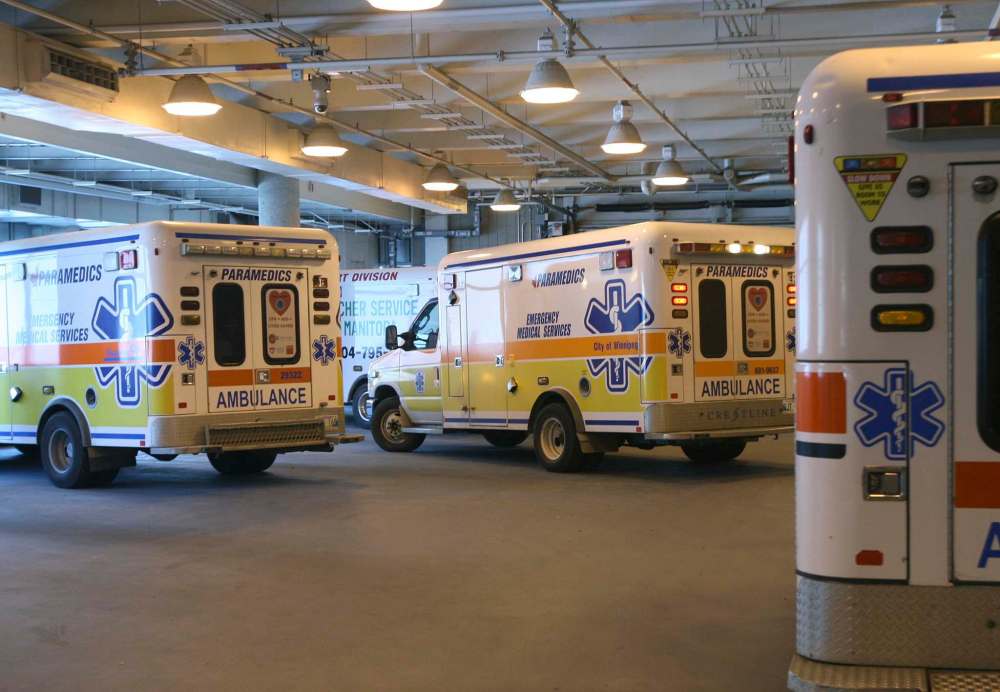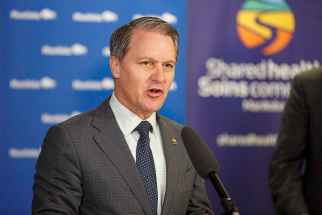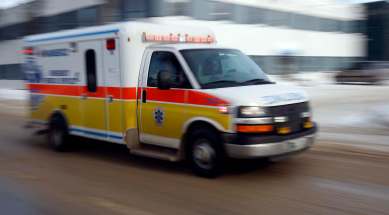Ambulances taxed by sharp rise in calls
Read this article for free:
or
Already have an account? Log in here »
To continue reading, please subscribe:
Monthly Digital Subscription
$0 for the first 4 weeks*
- Enjoy unlimited reading on winnipegfreepress.com
- Read the E-Edition, our digital replica newspaper
- Access News Break, our award-winning app
- Play interactive puzzles
*No charge for 4 weeks then price increases to the regular rate of $19.00 plus GST every four weeks. Offer available to new and qualified returning subscribers only. Cancel any time.
Monthly Digital Subscription
$4.75/week*
- Enjoy unlimited reading on winnipegfreepress.com
- Read the E-Edition, our digital replica newspaper
- Access News Break, our award-winning app
- Play interactive puzzles
*Billed as $19 plus GST every four weeks. Cancel any time.
To continue reading, please subscribe:
Add Free Press access to your Brandon Sun subscription for only an additional
$1 for the first 4 weeks*
*Your next subscription payment will increase by $1.00 and you will be charged $16.99 plus GST for four weeks. After four weeks, your payment will increase to $23.99 plus GST every four weeks.
Read unlimited articles for free today:
or
Already have an account? Log in here »
Hey there, time traveller!
This article was published 27/01/2020 (2142 days ago), so information in it may no longer be current.
The long-promised grey tsunami is causing the need for emergency medical services to rise while the number of ambulances available to respond has flatlined.
The rising number of seniors, with the majority of baby boomers now over the age of 65, is one of the factors seeing emergency medical service paramedics — the people who staff the city’s fleet of ambulances — respond to 73,420 medical incidents in 2019, an increase of 31 per cent since 2015, according to data provided by the Winnipeg Fire Paramedic Service on Monday. It also shows more first responders are getting injured on the job

!function(e,i,n,s){var t=”InfogramEmbeds”,d=e.getElementsByTagName(“script”)[0];if(window[t]&&window[t].initialized)window[t].process&&window[t].process();else if(!e.getElementById(n)){var o=e.createElement(“script”);o.async=1,o.id=n,o.src=”https://e.infogram.com/js/dist/embed-loader-min.js”,d.parentNode.insertBefore(o,d)}}(document,0,”infogram-async”);
But deputy WFPS chief Christian Schmidt said one thing hasn’t changed between 2015 and 2019 and it is a problem — the number of ambulances on the road.
Schmidt said there is still an average of 28 ambulances on the streets of Winnipeg, but there are at least six more ambulances needed because of the increased numbers of people calling for help. Each new ambulance would cost $2.2 million for staff, training and overhead, but the $412,000 training cost would come off after the first year.
"The system is under stress," he said.
"We will see our indicators go up – our target response time is eight minutes and 59 seconds but we already have seen it increase to the 13 minute mark."
The WFPS statistics show that four years ago paramedics were on scene within seven minutes and 40 seconds.
But Schmidt said it’s not just because an increased number of seniors need ambulances. He said adults aged 25 to 35 have also seen a spike in numbers, and it’s not due to the ongoing problems connected to methamphetamine.
“The system is under stress. We will see our indicators go up – our target response time is eight minutes and 59 seconds but we already have seen it increase to the 13 minute mark.” – Deputy WFPS chief Christian Schmidt
"We don’t know why, but we do know these two demographics are going up," he said.
When the numbers are broken down, each ambulance is responding to an average of seven medical incidents a day, according to data collected by the WFPS.
Of the 28 available ambulances, WFPS officials say 17 units are available 24 hours a day and 11 units are available 12 hours a day during peak times to handle higher call volumes.
Funding for paramedic services in Winnipeg has been frozen since 2016 when a service agreement between the City of Winnipeg and Shared Health expired. The city is responsible for providing emergency medical services, paramedicine, and inter-facility transportation under a service contract with Shared Health, an organization that provides oversight to emergency response services in Winnipeg and provides paramedic service across the province.
The City of Winnipeg and Shared Health have yet to agree to terms of a new service contract.
A spokesperson for Shared Health said they would not be able to comment until Tuesday.
Meanwhile, last year, firefighters and paramedics in Winnipeg took nearly 9,400 days off due to illness or injury — the highest number of sick days recorded since 2016.

!function(e,i,n,s){var t=”InfogramEmbeds”,d=e.getElementsByTagName(“script”)[0];if(window[t]&&window[t].initialized)window[t].process&&window[t].process();else if(!e.getElementById(n)){var o=e.createElement(“script”);o.async=1,o.id=n,o.src=”https://e.infogram.com/js/dist/embed-loader-min.js”,d.parentNode.insertBefore(o,d)}}(document,0,”infogram-async”);
Schmidt said workers compensation cost the service about $500,000 in 2015, but by 2018 it was costing more than $1 million.
"There’s a need for additional resources," he said.
But Ryan Woiden, president of Manitoba Government and General Employees’ Union Local 911, said part of the solution could be to do what many other cities have begun doing – not sending two-person ambulances to as many calls.
As well, Woiden said that the city’s almost two decade old system of having medically trained firefighters in a fire truck arrive first at an address with an ambulance crew to follow, should be examined.

"The current system doesn’t do anything to reduce the use of ambulances – but you do have people at your door," he said.
"We need to send a highly trained paramedic in a single sport utility vehicle who can treat an acute need. They are doing this in other cities and other provinces but we’re not looking at it and I don’t know why. A great deal of people we can treat and leave at their home.
"Some cities have 75 SUVs going around the city… if we had 25 we would be able to reduce costs… We want Shared Health to look at this."
kevin.rollason@freepress.mb.ca
danielle.dasilva@freepress.mb.ca

Kevin Rollason is one of the more versatile reporters at the Winnipeg Free Press. Whether it is covering city hall, the law courts, or general reporting, Rollason can be counted on to not only answer the 5 Ws — Who, What, When, Where and Why — but to do it in an interesting and accessible way for readers.

Our newsroom depends on a growing audience of readers to power our journalism. If you are not a paid reader, please consider becoming a subscriber.
Our newsroom depends on its audience of readers to power our journalism. Thank you for your support.











